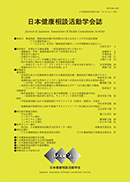A Yogo teacher offers consultation with regard to health care by attending to the mental and physical development of students. It is considered important to focus on the interpersonal skills of these students, who frequently visit the health center for health consultation activities. In this study, with the aim of examining interpersonal skills, I directed my focus on the students' abilities of the development of interpersonal relationships. In addition, the students were subject to an evaluation of their inter‐personal activities, particularly with help from the School Health Committee. First, the Health Committee decided on the formulation of a questionnaire so as to grasp the actual health conditions of the school students, and the investigation that followed was effective in serving this purpose. Further, I worked on enlightenment for a clarified health problem and evaluated the health education activities. In the activities carried out by the Committee, the health problems, which were discussed this time around, did not revolve around human relationships and communication. Therefore, the enlightenment activity will announce the contents about personal relationships at a student meeting. Following the announcement of the results of the survey, there was a conscious transformation of the communication skills of the students. I requested the School Health Committee to conduct questionnaire surveys in each class in order to determine the actual health conditions of their students and, therefore, work toward promoting health awareness. As a result, discussions on health issues were held and this led to the development of interpersonal relationships between students. Moreover, due to this activity, the overall awareness of students' with regard to interpersonal relationships has considerably increased.
View full abstract
